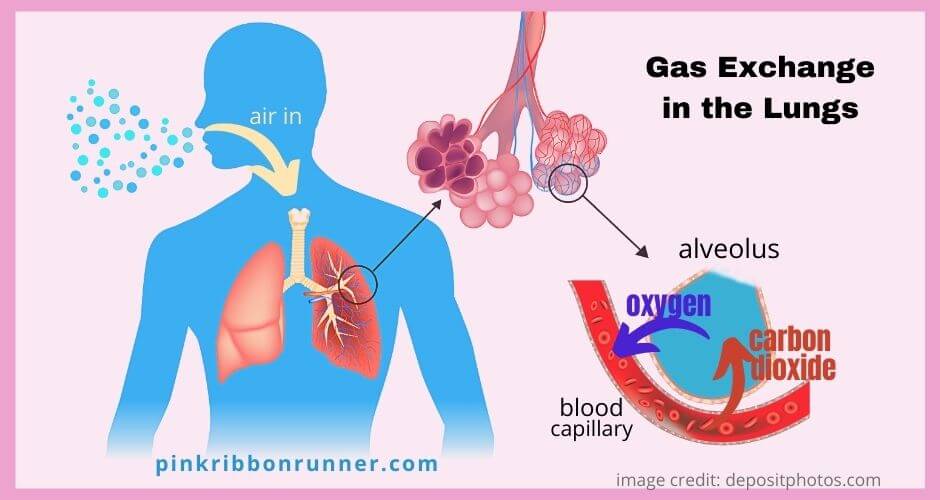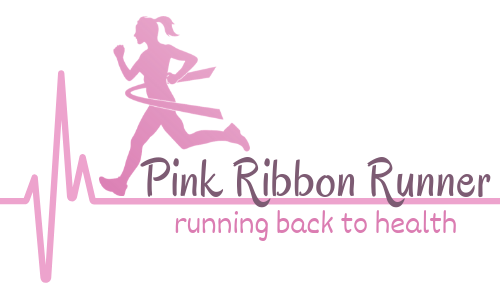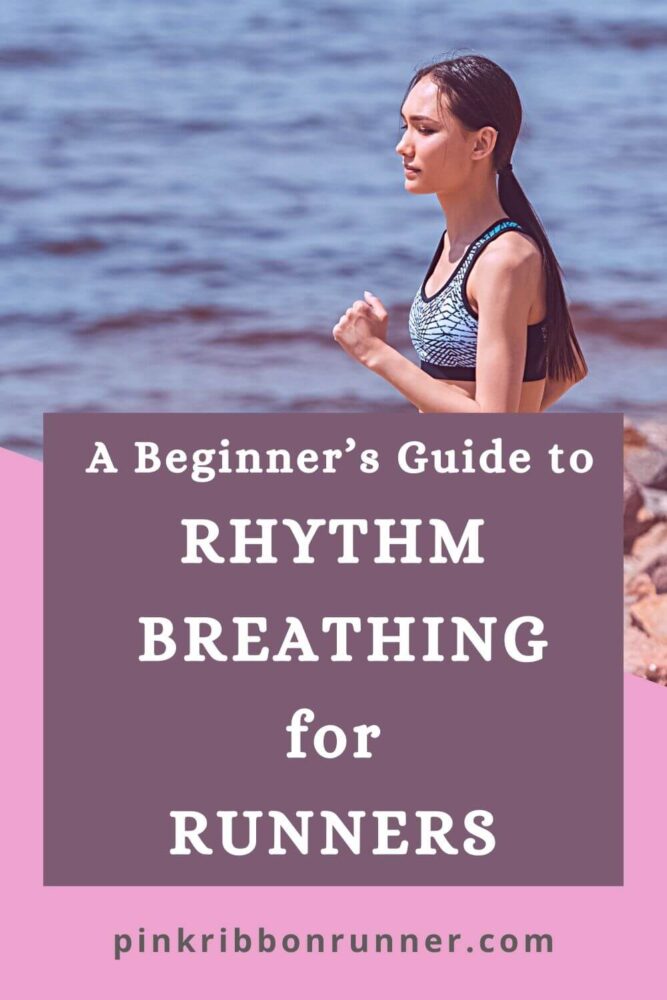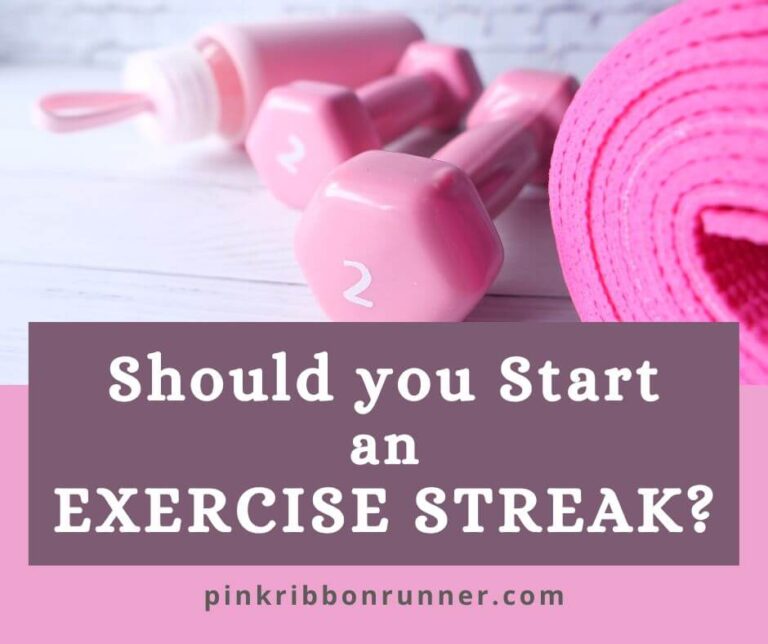Rhythmic Breathing for Running; Beginner’s Guide on How to Breathe
If you search How to Breathe while Running, you will get many different views and advice. This can be extremely confusing for the beginner runner. What is the best way to breathe during a run? Well, let me help you sift through the multitude of information and expert advice on this. I will tell you a technique, called Rhythmic Breathing for running, that helped me make it easier to breathe during my runs. Perhaps then, you can run more efficiently with less struggle too.
This post contains affiliate links. As an Amazon Associate, I earn from qualifying purchases.
A Reflection on Breathing while Running
This past year has been a time of running reflection for me. Because most of my runs have been solo, I have been able to pay closer attention to how I run. And that sparked my curiosity to answer the commonly asked question “what is the best way to breathe during a run?’.
I enjoy running, as it helps me feel good both physically and mentally. I also like to try to find ways to run more efficiently, so I can run longer. During this year of running reflection, I found a breathing technique that helps me do just that. I discovered Rhythmic Breathing for running.
Why do I Struggle to Breathe When Running?
Running doesn’t come easy for me. I am not graceful or fast. I am more like a Clydesdale horse that snorts and sputters as it trots out of the barn. And perhaps running doesn’t come easy to you either, otherwise you wouldn’t be reading this article.
Part of the reason we struggle to breathe on runs is that we aren’t getting enough oxygen in and carbon dioxide out.
Your muscles need oxygen as fuel to keep going. And with each breath in, you also breathe out carbon dioxide. The exchange of these two components happens down deep in your lungs in a little sac called an alveolus. You have about 500 million of these tiny little sacs in your lungs. They allow oxygen to get into your blood stream to fuel your muscles. And they allow carbon dioxide to be expelled into your airways, so that you can exhale this waste gas.

When you are resting, this system of breathing out carbon dioxide and breathing in oxygen works well to easily meet the low demand. But when you are running, your muscles are working hard and producing lots of carbon dioxide. It is this build up of carbon dioxide in the blood that tells your brain to breathe heavier. So, you start to breathe faster and deeper. And your heart also beats faster to pump that oxygen rich blood to your working muscles.
But as you work harder than you are accustomed to, the levels of carbon dioxide rise sharply. Your heart pumps this carbon dioxide rich blood to all the alveoli in your lungs. But there isn’t much oxygen there because you are breathing so quickly just to keep up with the demand to get rid of all that carbon dioxide waste. So, the blood returns to your muscles with an inadequate supply of oxygen. You end up feeling tired, your legs feel heavy, and you may even start cramping.
Know this feeling? I will bet that you do. I do!
This is one of the reasons you are struggling to breathe while running. Your body is not accustomed to the level of effort you are asking your muscles to do. And you haven’t trained your body to meet the respiratory demand of getting enough oxygen in and carbon dioxide out.

How Do You Run Without Getting Out of Breath?
You are getting out of breath when you run, ultimately, because you aren’t taking in enough oxygen to exchange with carbon dioxide.
There are other things, besides increased run effort, that can cause you to be out of breath. Respiratory illness, allergy, asthma, heart disease, air contamination, humidity and hot weather can all affect your ability to get enough oxygen in. But let’s assume, and I hope this is the case, that you have perfectly functioning heart and lungs. If you don’t know for sure, please go see your doctor before you start running.
Always see your doctor or health care professional before beginning any exercise program, especially learning to run. For the rest of this article, I will assume your doctor gave you the thumbs up.
So, to run without getting out of breath, you need to get more oxygen into your lungs and more carbon dioxide out.
How can you get more oxygen into your lungs when running?
One of the first things to look at is your running posture. For oxygen to get to your lungs, it needs to be pulled into your trachea, down through your bronchi, across your bronchioles and into the lungs. It goes through smaller and smaller airway tubes until it gets to those little alveolar sacs.
If there is an abnormal bend to your body, such as slouching, then those tubes can’t open as well. So, to keep those airways wide-open, pay attention to your posture while running.
Look straight ahead so that you don’t bend your neck and throat. Keep your back straight with shoulders back, but relaxed, to open your airway and give your respiratory muscles room to expand your rib cage.
Try this:
Sit up in your chair right now. Look straight ahead and straighten your back. Take a deep breath in and let it out. Now roll your shoulders forward into a slouch and look down at the floor. Take another deep breath in and let it out. Feel the difference? There isn’t enough room for your diaphragm and ribcage to fully draw that breath in and out when you were slouched, was there?
Should I Breathe Through My Nose or Mouth When Running?
My best advice to you is just breathe. There are so many things to think about when you are learning to run, you don’t need to worry about nose or mouth breathing. Breathe so that you can get sufficient air into your lungs. It doesn’t matter if that is via your nose or your mouth. Just get that oxygen in any way you can.
Now, if you want to dive deep into nose vs mouth breathing, then let’s look at the pros and cons of each.
Pros and Cons of NOSE BREATHING while Running
Pros:
- Nose breathing heats the air a little on its way in.
- Nose hairs filter out air pollution and dust.
- As air passes through your nose, it moisturizes the air coming in.
- Some studies suggest that nose breathing may increase oxygen uptake by the lungs.
Cons:
- Nostrils are smaller in diameter than your mouth.
- Nose breathing may make it difficult to get enough air.
- Studies suggest that advantages of nose breathing are limited when breathing quickly.
- Runners tend to tighten their jaw and face muscles while nose breathing.
Pros and Cons of MOUTH BREATHING while Running
Pros:
- Your mouth is wider than your nostrils, so can get more air in.
- Your mouth is more efficient at air exchange.
- Mouth breathing while running allows for relaxed muscles in your jaw and face.
Cons:
- Mouth breathing dries out your mouth.
- Your mouth doesn’t filter, heat or moisturize the air before it enters your trachea.
- Bugs! Flying critters can get into your open mouth. Yuck.
So, Is Mouth Breathing Bad?
No, mouth breathing is not bad. There may be more advantages to breathing through your nose, especially for people with asthma or depending on the air conditions. But if you can’t get enough air in through your nose, it ultimately doesn’t matter anyways. You need oxygen when your muscles are working hard. And the advantages of nose breathing are less when you are working out at this level anyways.
So, if you need to breathe through your mouth to get enough air in when you run, go for it.
I am a mouth breather. I was born with a deviated nasal septum and had surgery to correct it when I was a teenager. So, I never really developed the habit of breathing through my nose.
I think breathing through your nose or mouth is a personal preference. If you are a nose breather, that is awesome. You may have a slight advantage over the rest of us.
Just get the air into your lungs any way you can. Let your millions of alveoli take care of the rest.
What is Rhythmic Breathing for Running?
Now let’s get to the part that I really want to tell you about. I have been practicing rhythmic breathing on my runs for many months now, just to see if it works. It works! So, pay attention to the rest of the article if you struggle to breathe while running.
Rhythmic breathing for running is a system of matching your breaths in and out with your foot strikes. I started it earlier this year after extensively researching how to breathe while running. It is a simple concept, that is not so simple to implement.
What are the Benefits of Rhythmic Breathing while Running?
When you focus on your foot strike and breathing pattern, you are more in control of your running effort. What do I mean by this? Let’s look at what I learned from the book, “Running on Air” by Budd Coates.

Remember, that if you increase the amount of work your muscles do, you increase your heart rate and your respiratory rate. You can’t really control your heart rate. But you can control your breathing. To some extent, you can consciously control both the rate and rhythm of your breathing while running. So, essentially, you can control how much oxygen your body takes in. And supplying your working muscles with more oxygen helps them work better, so your running will improve.
Rhythmic breathing allows you to maximize this for the effort you are doing. Run faster by increasing the number of foot strikes and you can consciously increase the rate of breathing. Run slower and you decrease your breathing rate. You can maximize each cycle of breathing and foot strikes to get all the oxygen your body needs to do the work at the pace you are running.
There are other advantages that science has also discovered, such as making you less prone to injury if you have an odd-numbered breathing pattern, reducing the workload on your respiratory muscles, preventing side-cramps, and improving efficiency of oxygen exchange in your lungs.
How do you breathe rhythmically while running?
The easiest way to consciously maximize the rate and rhythm of your breathing on a run is to match your in-breaths and out-breaths with your foot strikes. So, how do you do this? Let me tell you how I did this. Maybe it will help you too?
How do I breathe while running?
The first step I did was to go on a run by myself with no distractions. I counted each foot strike as I ran. 1 – 2 – 3 – 4 – 5, 1 – 2 – 3 – 4 – 5, 1 – 2 – 3 – 4 – 5, 1 – 2 – 3 – 4 – 5, and so on. I was just getting myself use to counting foot strikes.
On my next run, I counted foot strikes again. But this time I tried to notice when, during that 1 – 2 – 3 – 4 – 5 count, I took a breath in and when I took a breath out. I was trying to determine what my current, natural breathing pattern was.
There are basically 3 different patterns talked about by run coaches: 2:1, 2:2 and 3:2. These are the number of steps per in-breaths and out-breaths. So, a 2:2 pattern is breathing in for two foot strikes and breathing out for two. A 3:2 pattern is breathing in for three foot strikes and breathing out for two.
I learned that I was naturally a 2:2 pattern breather when I run.
What is the Best Breathing Rhythm for Running?
So, I was a 2:2 breather while running. But was this the best breathing rhythm I could achieve?
There is controversy about this in the run coaching world. Some coaches train the 2:2 pattern as best. Other coaches think an odd-numbered pattern, such as 2:1 or 3:2 is better. Maybe it is personal preference?
But science says that odd-numbered patterns may help reduce the risk for injury. And this is because breathing out as your foot hits the ground puts greater stress on that same leg. So, if I was breathing out in a 2:2 pattern, one leg was always receiving greater impact as I breathed out. The rational part of me then agreed with Budd Coates’ method of alternating legs receiving the greatest impact. This made sense to me, as the stress of impact is distributed over both legs, rather than just one.
So, my next goal was to teach myself to breathe in for 3 foot strikes and out for 2.

How do I Control My Breathing While Running?
I wanted to teach myself a 3:2 pattern of rhythmic breathing for running. I set out to do this on my 3rd run after reading Budd Coates’ book.
It didn’t go so well in the beginning. I was constantly messing up. I kept wanting to go back to a 2:2 pattern. But then I remembered something my scuba diving instructor drilled into my head years ago; breathe out to breathe in.
So, I focused on breathing out. I repeated in my head: out-2-in-2-3, out-2-in-2-3, out-2-in-2-3, out-2-in-2-3, and so on. I finished the run with this pattern stuck in my head.
It took several runs to get the rhythm right. And it took many more to establish this as a pattern without thinking about it. But eventually, as I continued to train my breathing, it became my new go-to.
Occasionally, when I am tired, I still need to count out-2-in-2-3. But overall, I have successfully become a 3:2 breather.
How Can I Increase My Lung Capacity for Running?
One thing I found, in the beginning, that it isn’t easy to get all that air in for 3 foot strikes. I wasn’t used to breathing to that depth. I needed to increase the amount of air I was getting down into my lungs by becoming a belly breather. So, I started to do some abdominal breathing exercises at home, when not running.
There are many ways to do abdominal breathing exercises. I did the ones taught to me in a health course I took recently.
Abdominal Breathing Exercise
If you want to follow along with the exercises I did, here are the steps for deep belly breathing:
- Either sit in a chair or lay down flat on your back with knees raised up.
- Put one hand on your belly and the other on your chest.
- Breathe in as deeply as is comfortable, paying attention to your hands.
- Try to inhale so that the hand on your belly raises up more than the one on your chest.
- Hold this deep belly breath for a count of three.
- Slowly breathe out through pursed lips, almost whistling as you push the air out.
- Towards the end of the exhale, push out the final air by contracting your core abdominal muscles.
- Repeat several of these breaths during one round of exercise.
I would do these abdominal breathing exercises when I could. It only takes a few minutes to do these. And they can be done anywhere.
These exercises are also calming and can help relieve stress and anxiety. They can help with pain perceptions, as well. And they did eventually allow me to breathe deeper during my runs.
Will my Breathing Get Better the More I Run?
Has all this rhythmic breathing for running made a difference in my running? Yes, I think it has. I am enjoying a much easier run these days. And I don’t seem to get as tired or sore as I did before. I feel I am getting more oxygen in, and I like to think my muscles are loving it.
Will rhythmic breathing help me run injury free? Well, only time will tell. I haven’t been doing it long enough yet. But so far, so good.
I will continue to train to breathe rhythmically during all my runs. As with most things, the more you do it the better you get at it.
Should beginner’s train to breathe rhythmically? Well, if you are struggling to breathe while learning to run, then yes, why not set off on the right track.
But if this is a lot to take in, as it was for me, then just breathe! There are so many things to think about when learning to run. So, just straighten up, look forward and breathe any way that gets air into your lungs.
– Just keep running –
Read More:
7 Things You Can Do Right Now to Run Faster
Runner’s Guide to Muscle Recovery
12 Fun Ways to Workout on a Treadmill
How to Start Running – A Guide for Beginners









Great information here! Posture is so important for breathing. I love all the pros and cons listed provided and think the content was very informational!
Glad you found it helpful. Thank you for taking the time to comment.
Nice article. I will add that in exercise sone research suggests emphasizing the effort on exhaling because the inhaling is more automatic and with stress it’s an instinct to hold our breath. If you don’t completely exhale you are unable to take as deep breath in as you might want.
So very true! It is the reason behind the “breathe out to breathe in”. Thank you for commenting.
This is so much I’ve never known about running. I honestly run and never take into consideration the things that go on with my body. I loved how much you’ve taught me about running without getting out of breath. Especially, learning about posture. It is wonderful to know that there are these ways that I’ve probably disregarded without even realizing could help improve my breathing. Thank you also for the tip and how to practice and get an idea on how to correct one’s posture.
Additionally, I always questioned that as well. Breathing through my mouth or nose, which is the right choice. However, you debunked that curiosity I had on my mind. I will need to take your helpful tips into consideration, as it’s super helpful and explains and resolves so many issues I’ve faced. Thank you ☺
I am so happy you found the article informative. It is interesting that all the little things, like posture and breathing, that can make running easier. But some days, it is wonderful to not focus on all these things and just run! Happy running!